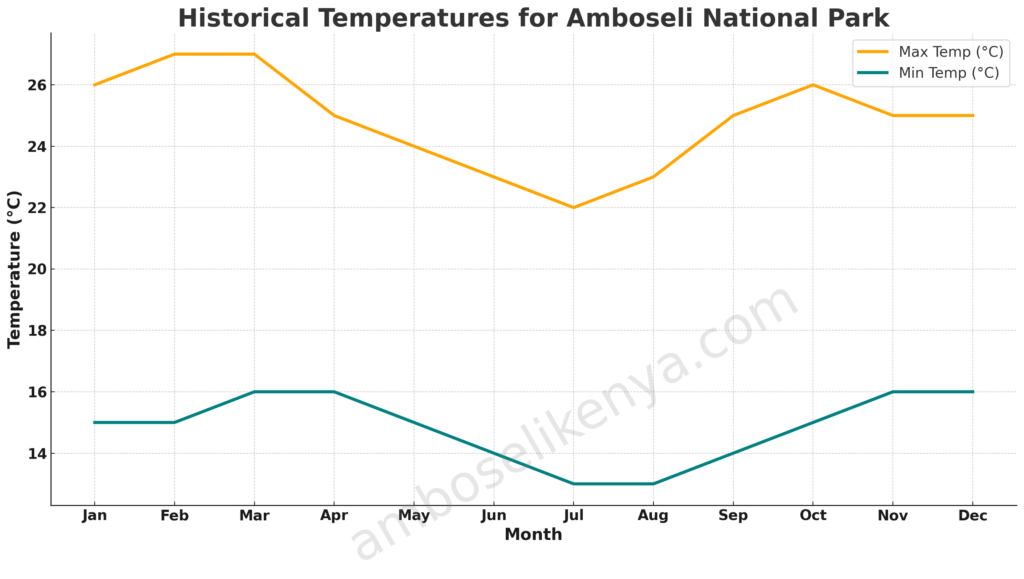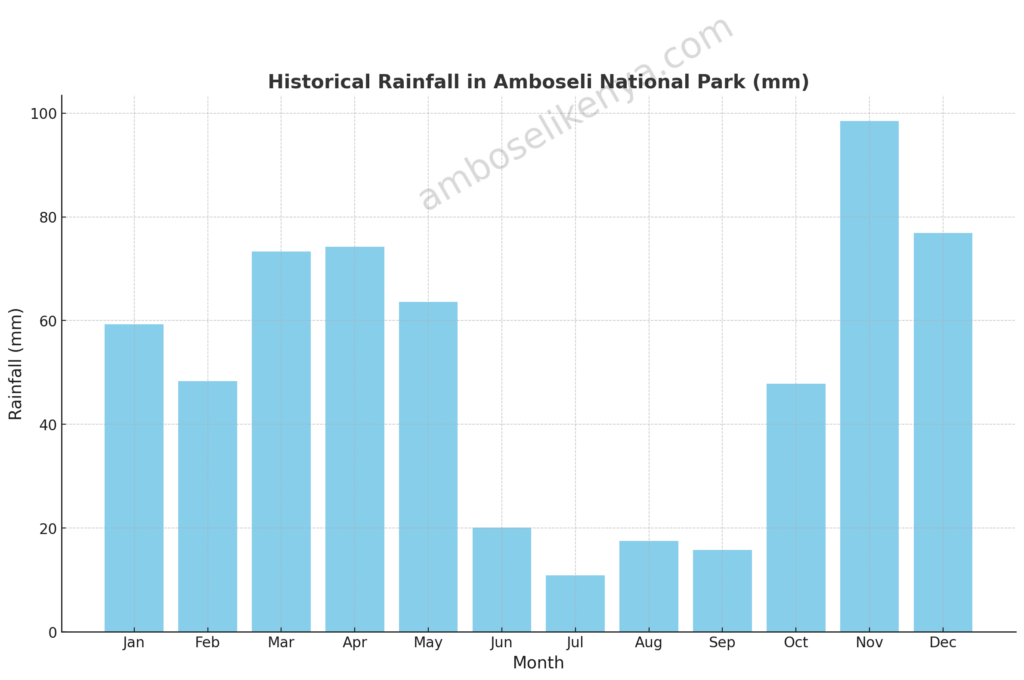Amboseli National Park, located in southern Kenya, near the Tanzanian border and at the foot of Mount Kilimanjaro, is a renowned safari destination. The park’s weather is defined by distinct wet and dry seasons, offering travelers varied experiences throughout the year. Understanding Amboseli’s weather patterns is crucial when planning your trip to ensure you make the most of your safari experience.
Overview of Amboseli’s Climate
Amboseli enjoys a semi-arid climate with generally warm temperatures throughout the year. The park sits at an elevation of about 1,150 meters (3,800 feet) above sea level, which moderates the temperatures, keeping them pleasant for most visitors. However, the park’s proximity to Mount Kilimanjaro also affects the climate, as the mountain influences local rainfall and temperature patterns.


The park’s climate can be broken down into two major seasons:
- Dry Season (June to October)
- Wet Season (November to May)
Both seasons offer unique opportunities for wildlife viewing and photography, with distinct advantages depending on what you seek to experience during your visit.
Dry Season: June to October
The dry season is the most popular time to visit Amboseli, offering optimal conditions for game viewing. With little to no rainfall, the animals congregate around the remaining water sources, making it easier to spot a wide range of species.
- June to August: Cool and Dry
- Average Temperatures: Daytime highs range from 22°C to 23°C (72°F to 73°F), while nighttime lows drop to around 13°C to 14°C (55°F to 57°F).
- Rainfall: Minimal, ranging from 10 mm to 20 mm, meaning the landscape becomes dry and dusty, but it is great for wildlife viewing.
- What to Expect: Vegetation is sparse, so animals are easier to spot near waterholes, especially elephants, giraffes, zebras, and wildebeest.
- Packing Tips: The mornings and evenings can be chilly, so bring warm layers for early morning game drives.
- September to October: Warming Up
- Average Temperatures: Daytime highs increase to 25°C to 26°C (77°F to 79°F), and nights remain cool around 14°C to 15°C (57°F to 59°F).
- Rainfall: Still low, around 15 mm to 20 mm, but humidity starts to increase in anticipation of the upcoming rains.
- What to Expect: The animals are still concentrated around water sources, but the skies tend to be clearer, making for stunning photography of wildlife with Mount Kilimanjaro as a backdrop.
- Packing Tips: Light clothing for the warm days and a light jacket for the cooler mornings and evenings.
Wet Season: November to May
The wet season in Amboseli is divided into two parts: the short rains from November to December and the long rains from March to May. While some travelers may shy away from visiting during these months, the wet season has its own allure, including lush landscapes, fewer tourists, and a chance to witness the calving season.
- November to December: Short Rains
- Average Temperatures: Days warm up to 25°C to 27°C (77°F to 81°F), and nights cool down to 15°C to 16°C (59°F to 61°F).
- Rainfall: Rainfall increases, particularly in November, with about 50 mm to 100 mm of rain, but the rain typically comes in short bursts.
- What to Expect: The landscape begins to turn green, and there is still plenty of wildlife to see. Fewer tourists visit during this time, so you can enjoy a more private safari experience.
- Packing Tips: Bring a rain jacket and waterproof gear for your camera. A good pair of waterproof shoes or boots will also come in handy.
- January to February: Warm and Short Dry Spell
- Average Temperatures: The weather heats up, with highs of 27°C (81°F) and lows around 15°C to 16°C (59°F to 61°F).
- Rainfall: These months experience very little rainfall (10 mm to 30 mm), providing a brief dry period before the long rains.
- What to Expect: Wildlife sightings are still excellent, and the scenery is lush from the recent rains. January is also one of the best months for birdwatching, as migratory birds arrive from Europe and Asia.
- Packing Tips: Light clothing is suitable for the warm days, but a light jacket is still needed for cool evenings.
- March to May: Long Rains
- Average Temperatures: Daytime highs range from 23°C to 25°C (73°F to 77°F), while nighttime lows hover around 14°C to 16°C (57°F to 61°F).
- Rainfall: This is the wettest period, with rainfall levels reaching 90 mm to 150 mm in April. Thunderstorms are common in the afternoons.
- What to Expect: The park transforms into a green oasis, and many animals give birth during this time, providing exciting opportunities to see newborns. However, the rains can make some roads impassable, and wildlife may scatter, making sightings less predictable.
- Packing Tips: Bring sturdy waterproof gear and expect muddy conditions. You’ll need waterproof boots and a heavy-duty rain jacket.
Month-by-Month Guide to Amboseli Weather
| Month | Average Day Temp (°C) | Average Night Temp (°C) | Rainfall (mm) | What to Expect |
|---|---|---|---|---|
| January | 26°C | 15°C | 59 mm | Warm and relatively dry; good for wildlife and birdwatching. |
| February | 27°C | 15°C | 48 mm | Warm and mostly dry; ideal for game drives and birdwatching. |
| March | 27°C | 16°C | 73 mm | Onset of long rains; lush vegetation begins to appear. |
| April | 25°C | 16°C | 74 mm | Wettest month; beautiful scenery but some roads may become impassable. |
| May | 24°C | 15°C | 63 mm | Rains subside toward the end of the month; good time for a quiet safari. |
| June | 23°C | 14°C | 20 mm | Start of dry season; excellent game viewing as water sources dry up. |
| July | 22°C | 13°C | 11 mm | Cool and dry; great for game viewing and photography. |
| August | 23°C | 13°C | 17 mm | Similar to July; clear skies and good wildlife concentration. |
| September | 25°C | 14°C | 16 mm | Warmer and dry; still a great time for wildlife viewing. |
| October | 26°C | 15°C | 47 mm | Short rains begin toward the end of the month; landscape starts to green. |
| November | 25°C | 16°C | 98 mm | Short rains in full effect; fewer tourists but lush scenery. |
| December | 25°C | 16°C | 77 mm | End of short rains; wildlife still abundant and vibrant landscapes. |
January & February
- Temperature: Highs of around 26°C to 27°C (79°F to 81°F), with lows of 15°C (59°F).
- Rainfall: Short rains taper off by early January. These are generally warm months, making them excellent for wildlife viewing, particularly in the mornings and late afternoons.Traveler Tip: This is a good time for photography, as the rains clear the dust and provide a vibrant green backdrop.
March
- Temperature: Highs of 25°C (77°F), with lows of 16°C (60°F).
- Rainfall: Rainfall starts increasing, but it’s not too intense yet. This is the beginning of the long rains.Traveler Tip: The park is less crowded during this time, offering more serene safaris, though the occasional showers might interrupt activities.
April & May (Wettest Months)
- Temperature: Highs of 24°C (75°F), with lows of 15°C (59°F).
- Rainfall: These months bring the long rains, with the highest rainfall seen in April and May (74 mm to 98 mm).Traveler Tip: While the park is lush and teeming with wildlife, the roads can become muddy and difficult to navigate. A good time to consider fly-in safaris for easier access.
June
- Temperature: Highs of 23°C (73°F), with lows of 14°C (57°F).
- Rainfall: The rains subside, marking the start of the dry season.Traveler Tip: This is a perfect time for game drives as animals begin congregating around water sources. The clear skies also make for spectacular views of Kilimanjaro.
July & August
- Temperature: Highs of 22°C to 23°C (72°F to 73°F), with lows of 13°C (55°F).
- Rainfall: These months see the least rainfall (around 10 mm), making them some of the driest months in Amboseli.Traveler Tip: This is the best time for safaris, with dry conditions making it easy to explore all parts of the park. Early morning game drives are a must!
September & October
- Temperature: Highs of 25°C (77°F), with lows of 14°C to 15°C (57°F to 59°F).
- Rainfall: Rainfall starts increasing again in late October but is still relatively low.Traveler Tip: Late September is ideal for those looking to avoid the crowds of the peak dry season while still enjoying good wildlife viewing conditions.
November
- Temperature: Highs of 25°C (77°F), with lows of 15°C (59°F).
- Rainfall: The short rains begin, typically lasting until mid-December. Rainfall is moderate, around 47 mm.Traveler Tip: November offers a balance between fewer crowds and good game viewing. The vegetation is starting to become lush, making for beautiful landscapes.
December
- Temperature: Highs of 25°C (77°F), with lows of 16°C (61°F).
- Rainfall: Rain continues early in the month but starts tapering off by the end.Traveler Tip: The holiday season sees more visitors, but the rains are manageable, and the scenery is stunning.
Best Time for Wildlife Viewing
While Amboseli can be visited year-round, June to October is generally considered the best time for wildlife viewing. The dry conditions force animals to gather around waterholes, making them easier to spot. The clearer weather during these months also offers unobstructed views of Mount Kilimanjaro. For those interested in birdwatching or witnessing baby animals, the green season (November to May) is ideal, though some roads may be difficult to navigate after heavy rains.
Final Thoughts
Amboseli National Park offers a variety of experiences across its distinct seasons, with incredible wildlife sightings year-round. The dry season from June to October is the best time for game viewing, while the wet season offers lush landscapes and unique birdwatching opportunities. Whichever season you choose, Amboseli’s weather ensures that you will witness the majestic beauty of wildlife with the backdrop of Mount Kilimanjaro. Planning your visit according to the weather will help you make the most of your Amboseli safari experience.
